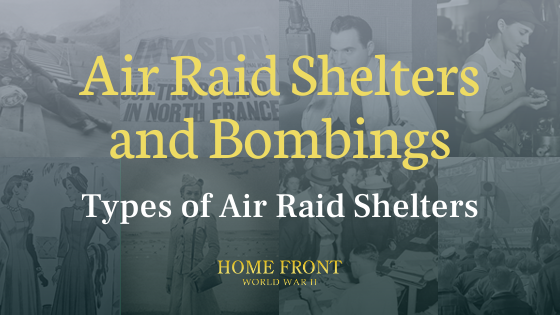Types of Air Raid Shelters
In Britain, there were multiple types of air raid shelters used during World War II. One was called the Anderson shelter, named after the Home Secretary (until 1940) John Anderson. This shelter could fit up to six people, and was designed to be used in the garden and be partially underground. It was made with a concrete floor and a steel roof and sidings before being covered with soil. This design, though, meant that dampness and water were constant problems. Still, over one million Anderson shelters were distributed immediately prior to the outbreak of the war. Many of which were provided free to low income families.
Another popular personal air raid or bomb shelter used in Britain was the Morrison shelter, named after Home Secretary (1940-1945) Herbert Morrison. This shelter was designed to be used inside the home and take up as little space as possible. The steel shelter had a flat top, removable mesh sidings, and a sprung base. When not being used as a shelter, the sides of the Morrison shelter could be removed and the structure could be used as a table, thus taking up even less space. It was to be used only on the bottom floor of a house and could protect those inside from the debris and rubble of a two- or three-storied building. The bottom was sprung to make it more comfortable to lie on. Since the structure was only 2.5 feet tall you could not sit or stand up inside. Morrison shelters could fit two adults and one or two children, depending on their size. This shelter was released in 1941 and allowed people to feel safer sleeping in their own homes. By 1945, there were over one million Morrison shelters in use in Britain.
THE MORRISON SHELTER. THIS WAS A TRIAL OF THE NEW SHELTER DESIGN FROM 1941. IMAGE COURTESY OF WIKIMEDIA COMMONS.
Outside the home, it was common for people to use the tunnels of the London Underground for shelter. Though initially hesitant, the government acknowledged that Londoners felt safer underground and opened up sections of the track to be used as air raid shelters. Parts of the track were ripped up and the stations were equipped with bunks, first-aid, and chemical toilets (outhouses). Approximately 170,000 people used the underground tunnels for shelter during the war.
Airplanes were certainly used in the First World War, but planes as weapons of war took on new roles during WWII. Developments in aviation in the interwar years allowed for planes to fly faster, farther, and carry heavier loads than in the previous conflict. Strategic bombing was practiced during WWI, but during the Second World War it was a major tactic. Bombing during WWII had two main targets: strategic targets, like munitions factories, air strips, and harbours; and civilian targets, like major cities. The intention behind hitting strategic targets was to limit the ability of an enemy nation to supply and perform acts of war; the latter was a direct attack on the morale of one’s enemies. There are infamous attacks on Allied centres, like the Blitz; however, the Allies also participated in civilian bombing. The devastating bombing of Dresden, Germany in February 1945 is one example. Such significant threats to civilian populations on the home front is one reason why WWII was considered a “total war.” This blog series will look at civilian bombing during the Battle of Britain, a few popular types of air raid shelters, and how the Canadian government prepared civilians for the potential of an air raid.


